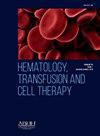一例罕见的弥漫性大b细胞淋巴瘤,表现为慢性胃肠道症状:一个诊断挑战
IF 1.6
Q3 HEMATOLOGY
引用次数: 0
摘要
弥漫性大b细胞淋巴瘤(DLBCL)是最常见的侵袭性非霍奇金淋巴瘤,但原发性胃肠道(GI)的累及仍然相对罕见。由于其非特异性症状,如慢性腹痛、体重减轻和贫血,可模仿良性胃肠道疾病,因此诊断胃肠道淋巴瘤具有挑战性。本病例强调了一个持续胃肠道症状的患者最终被诊断为DLBCL,强调了在无法解释的胃肠道症状和治疗难治性贫血的病例中考虑淋巴瘤的重要性。45岁女性,表现为持续8个月的上腹部疼痛、腹胀和消化不良。尽管进行了多次内窥镜和结肠镜检查,但未发现主动病理。由于持续症状和治疗难治性贫血,进行骨髓活检,报告为正常细胞。在接下来的两个月里,她经历了25公斤的意外体重减轻,这引起了对潜在恶性肿瘤的怀疑。FDG-PET/CT显示左腹及脐周肠壁弥漫性增厚,肠系膜淋巴结代谢活性增高,轻度骨髓摄取,肛管异常活动。考虑到淋巴细胞增生性疾病,患者接受了腹腔镜诊断,然后进行了切除肠系膜活检,证实弥漫性大b细胞淋巴瘤(DLBCL)为非生发中心b细胞表型。本病例强调了将淋巴瘤作为慢性胃肠道疾病鉴别诊断的一部分的重要性,特别是当淋巴瘤伴有无法解释的贫血和明显的体重减轻时,尽管内镜检查结果正常。它还强调了PET/CT在识别隐匿性淋巴瘤中的关键作用,以及在常规诊断方法无法揭示病因的情况下,切除活检对于明确诊断的必要性。早期识别和诊断GI-DLBCL对于及时治疗和改善患者预后至关重要。本文章由计算机程序翻译,如有差异,请以英文原文为准。
A RARE CASE OF DIFFUSE LARGE B-CELL LYMPHOMA PRESENTING WITH CHRONIC GASTROINTESTINAL SYMPTOMS: A DIAGNOSTIC CHALLENGE
Diffuse Large B-Cell Lymphoma (DLBCL) is the most common aggressive non-Hodgkin lymphoma, but primary Gastrointestinal (GI) involvement remains relatively rare. Diagnosing GI lymphoma is challenging due to its nonspecific symptoms, such as chronic abdominal pain, weight loss, and anemia, which can mimic benign gastrointestinal disorders. This case highlights a patient with persistent GI symptoms who was ultimately diagnosed with DLBCL, underscoring the importance of considering lymphoma in cases of unexplained GI complaints and treatment-resistant anemia. A 45-year-old female presented with eight months of persistent epigastric pain, bloating, and indigestion. Despite undergoing multiple endoscopic and colonoscopic evaluations, no active pathology was identified. Due to persistent symptoms and treatment-resistant anemia, a bone marrow biopsy was performed, which was reported as normocellular. Over the next two months, she experienced unintentional weight loss of 25 kg raising suspicion for an underlying malignancy. FDG-PET/CT was performed, revealing diffuse thickening of the bowel wall in the left abdomen and periumbilical region, increased metabolic activity in mesenteric lymph nodes, mild bone marrow uptake, and abnormal activity in the anal canal. Given the concern for a lymphoproliferative disorder, the patient underwent diagnostic laparoscopy followed by excisional mesenteric biopsy, which confirmed Diffuse Large B-Cell Lymphoma (DLBCL) of non-germinal center B-cell phenotype. This case emphasizes the importance of recognizing lymphoma as part of the differential diagnosis in chronic gastrointestinal complaints, particularly when associated with unexplained anemia and significant weight loss despite normal endoscopic findings. It also underscores the critical role of PET/CT in identifying occult lymphoma and the necessity of excisional biopsy for definitive diagnosis in cases where conventional diagnostic methods fail to reveal a cause. Early recognition and diagnosis of GI-DLBCL are crucial for timely treatment and improved patient outcomes.
求助全文
通过发布文献求助,成功后即可免费获取论文全文。
去求助
来源期刊

Hematology, Transfusion and Cell Therapy
Multiple-
CiteScore
2.40
自引率
4.80%
发文量
1419
审稿时长
30 weeks
 求助内容:
求助内容: 应助结果提醒方式:
应助结果提醒方式:


